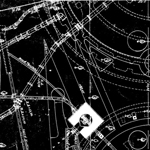|
|
 |
Dusted Reviews
Artist: Arnold Dreyblatt Album: Turntable History Label: Important Review date: Feb. 22, 2011 |

|
|
|
 |
Conlon Nancarrow transformed the player piano into high art. Alvin Lucier showed us the subtleties of slow sweep oscillators. Now, Arnold Dreyblatt renders poetry from an MRI machine and a vaulted water cistern. Turntable History is a document of icy beauty in which pitch, space and machine function in touching symbiosis.
In a way, the album’s title is misleading, as the turntable is a silent partner. In the 2009 installation of the same name, a “media turntable” (quotations from Dreyblatt’s website) projected images in and around the large circular space for which the project was conceived. The music was played over five strategically placed loud speakers, an effect that I imagine was somewhat reminiscent of Varese’s “Poème électronique,” written for the Philips Pavillion at the 1958 Worlds Fair. Beyond that, the parallel breaks down. According to the indispensible but scanty liner notes, Dreyblatt was given special permission to record the MRI’s unique language without a human subject, later grouping the results by sonic property to form the 40-minute composition.
As is the case with “Poème électronique,” there is obviously no way for a two-channel system to capture the full spatial impact of Dreyblatt’s sound sculpture. What is surprising, though, is just how much of a sense of space and perspective this recording affords. From the distant, pulsed trudge that opens the work, seeming to approach from ahead and to the right, the echoing timbres create an enthralling illusion of three dimensions. Echo is never overbearing, however, and in an astonishing feat of mixing prowess, each sound is layered to allow enough transparency and depth to fill any listening environment. Some sounds even seem to emanate from behind, hinting at the grandeur of the water container’s acoustics.
The mechanical sounds themselves are also responsible for the continuous illusion of perspective. As with an ensemble recording, such as 1995’s Animal Magnetism, the steady pulses traditionally associated with minimalism vie with unexpected tonal and rhythmic juxtapositions. Here, as with Lucier’s oscillators, a precision of rhythm and microtone is achieved far beyond the ability of even the finest musician to emulate, filling the soundstage with motions of their own. That opening pulse, the work’s heartbeat, creates a sense against which everything else seems somehow transient. We are also treated to similarly complex shifts in timbre. Listen to the first actual pitch of the piece, how it pulses and throbs unpredictably and how its timbre brightens. These are the relationships that propel Turntable History forward. Beats come forth from within each pitch and from the way the pitches interact, forming exquisitely intricate webs of polyrhythm that compliment the constantly morphing halos of morphing overtones. Consider one moment: at about 3:30 into the work, where a sudden shift in beat and tonality sweeps away everything that preceded it. There are too many such instances to catalog.
When we reach the concluding single pitch, and as the mechanized heartbeat fades, another sense of circularity is achieved, which was prefigured by the minute repetitions that form the music’s fabric. Even divorced from its visual elements, this is an essential addition to Dreyblatt’s all-too-small discography. It presents a facet of his art that has never been represented on disc with such clarity and fidelity.
By Marc Medwin
|







